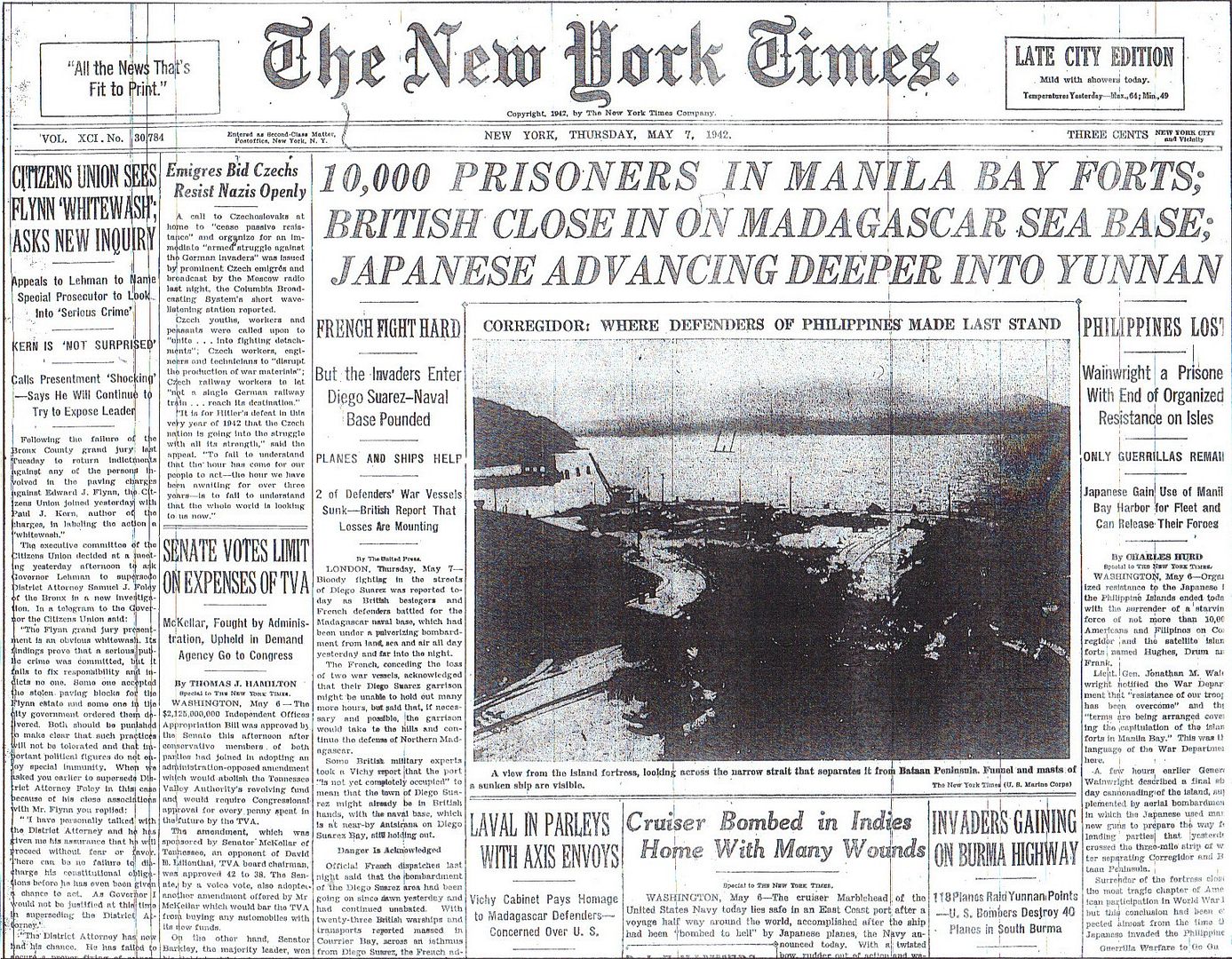
Posted on 05/07/2012 4:17:05 AM PDT by Homer_J_Simpson

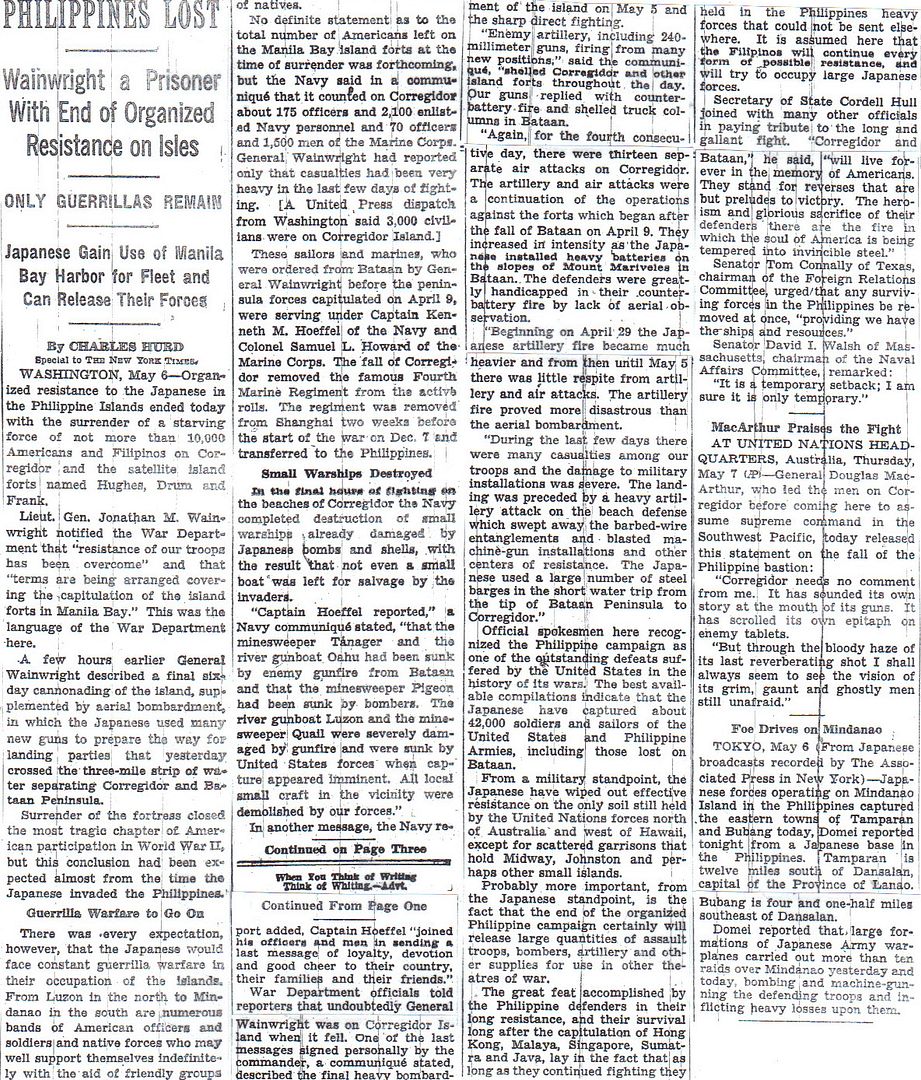
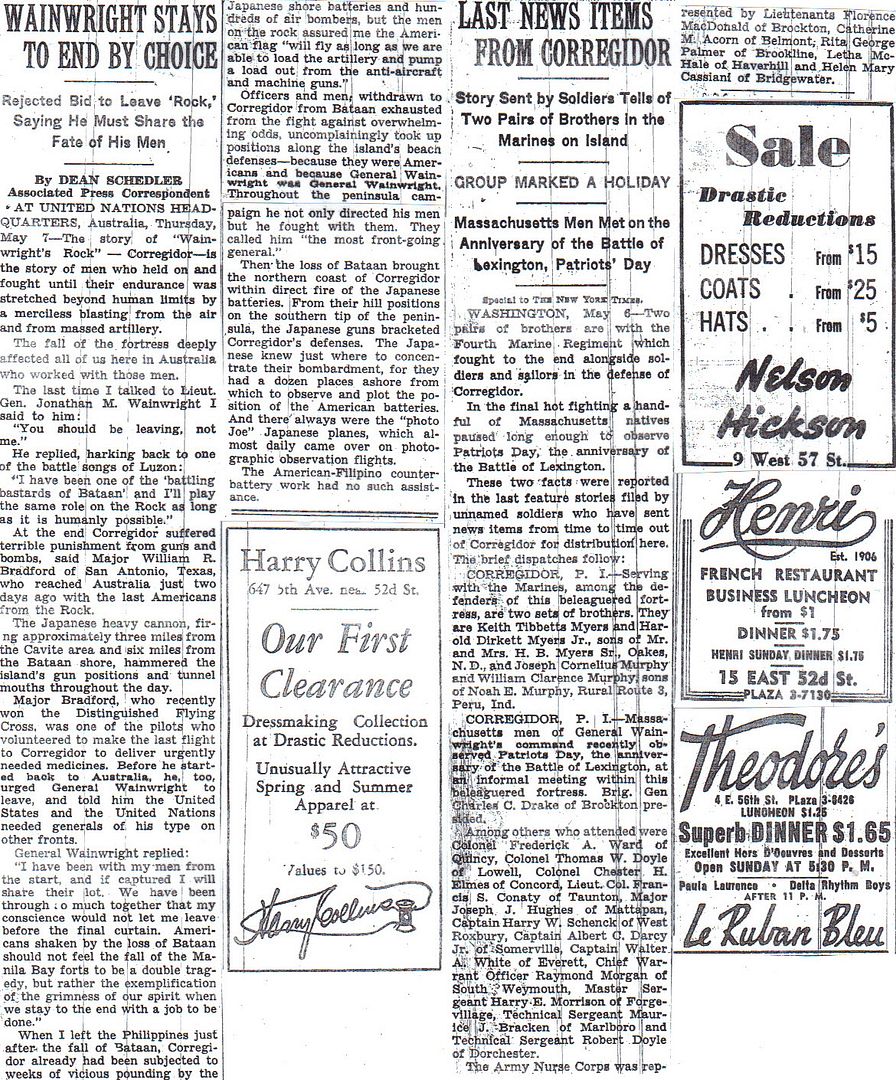
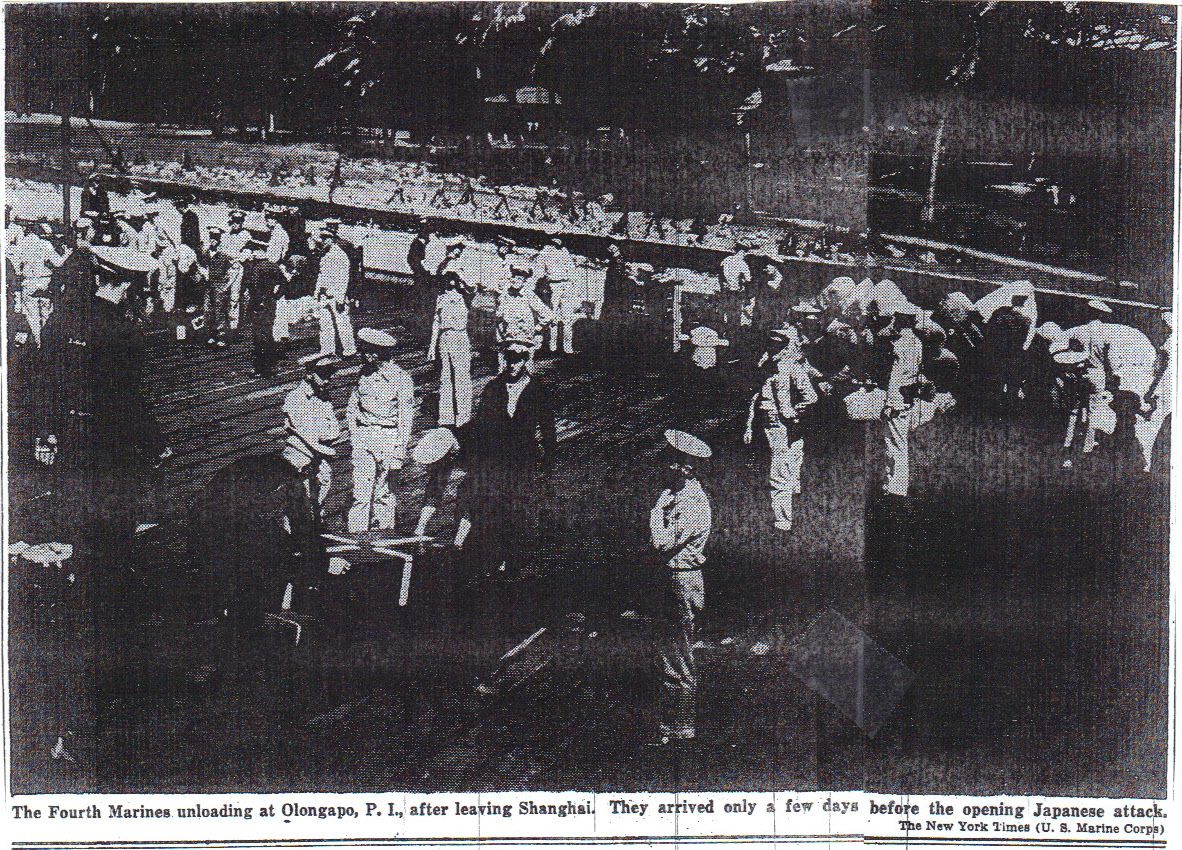
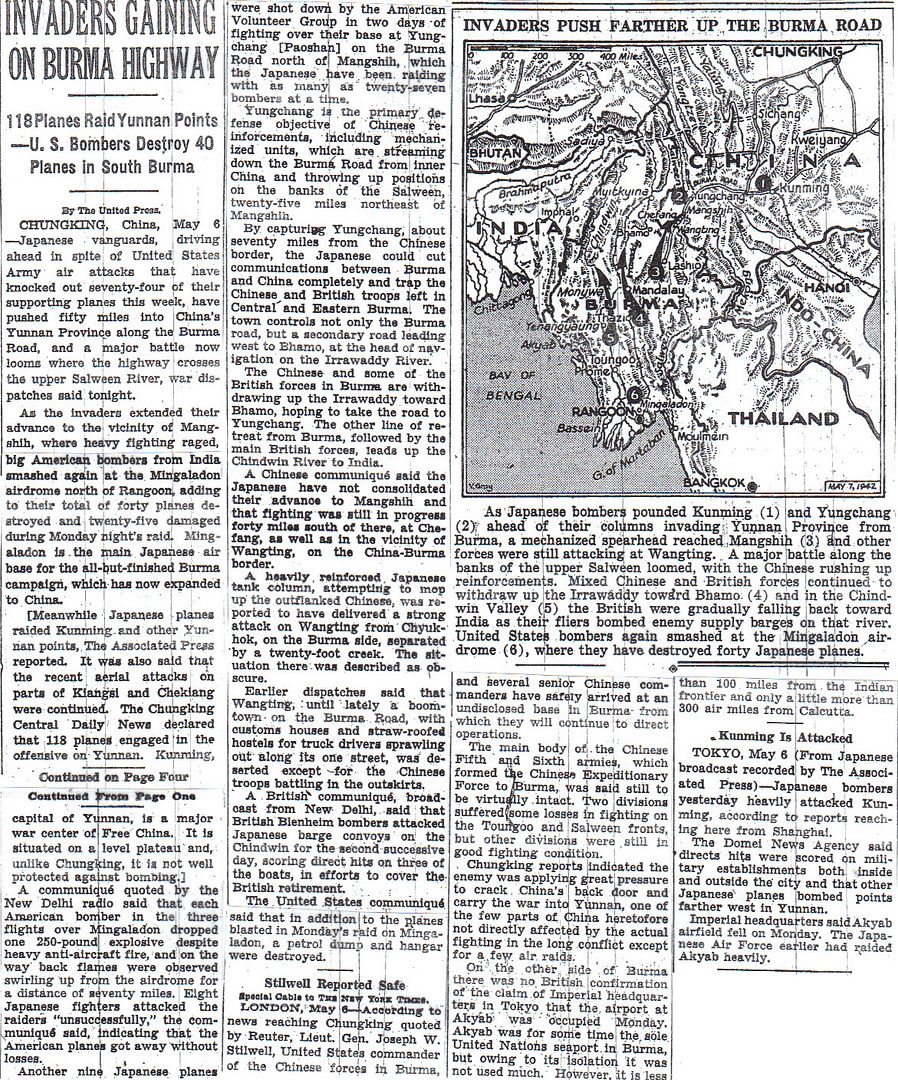
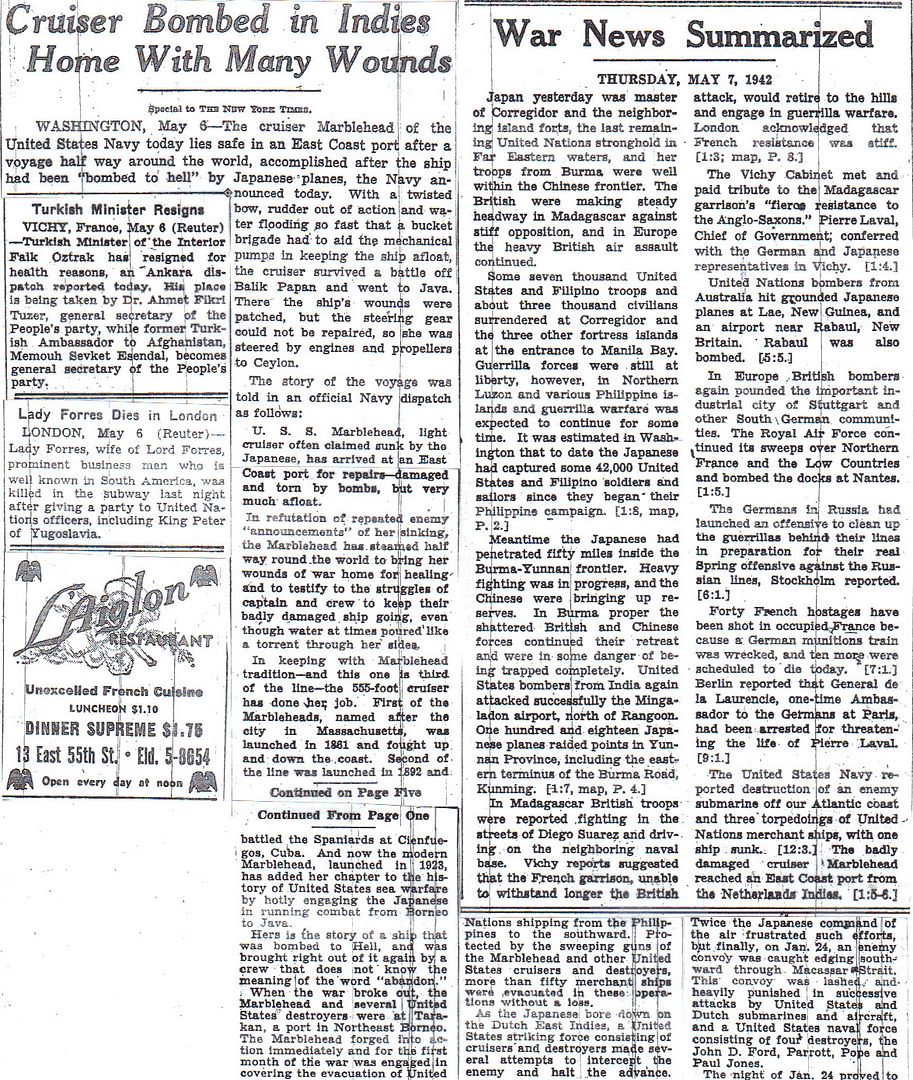
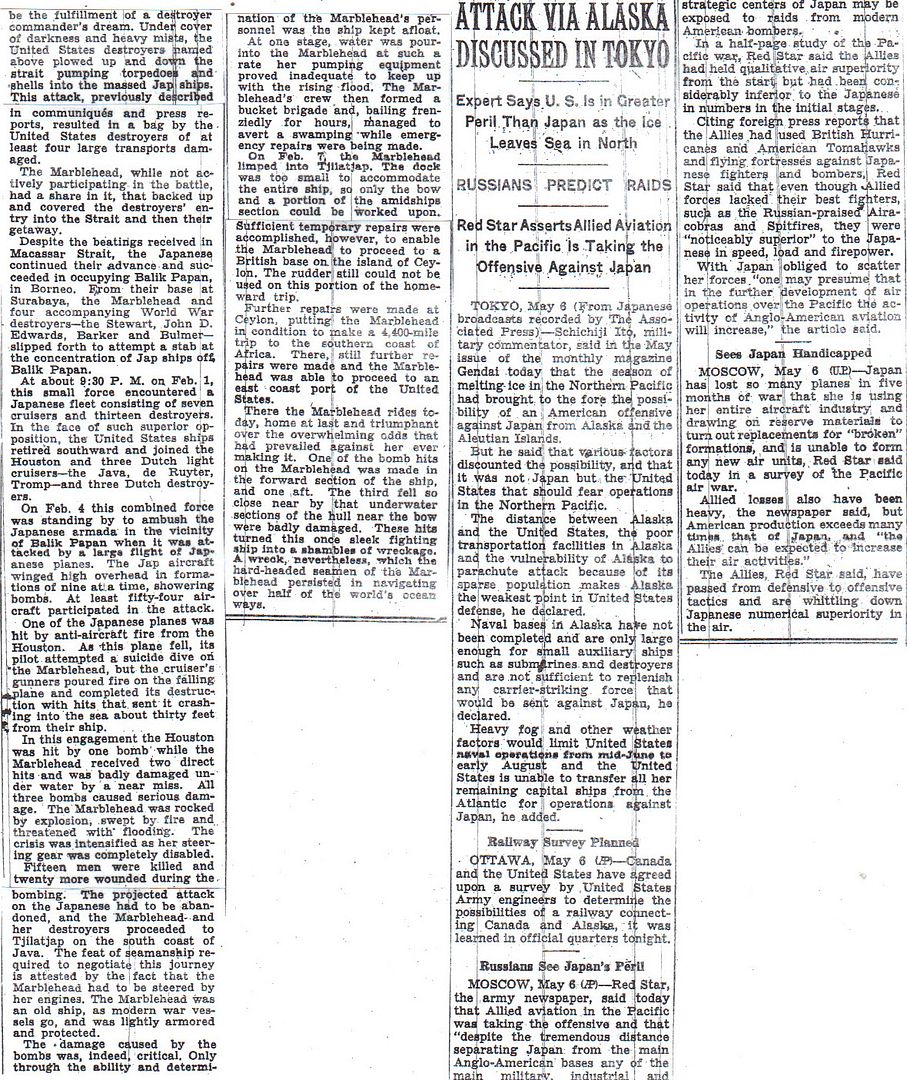
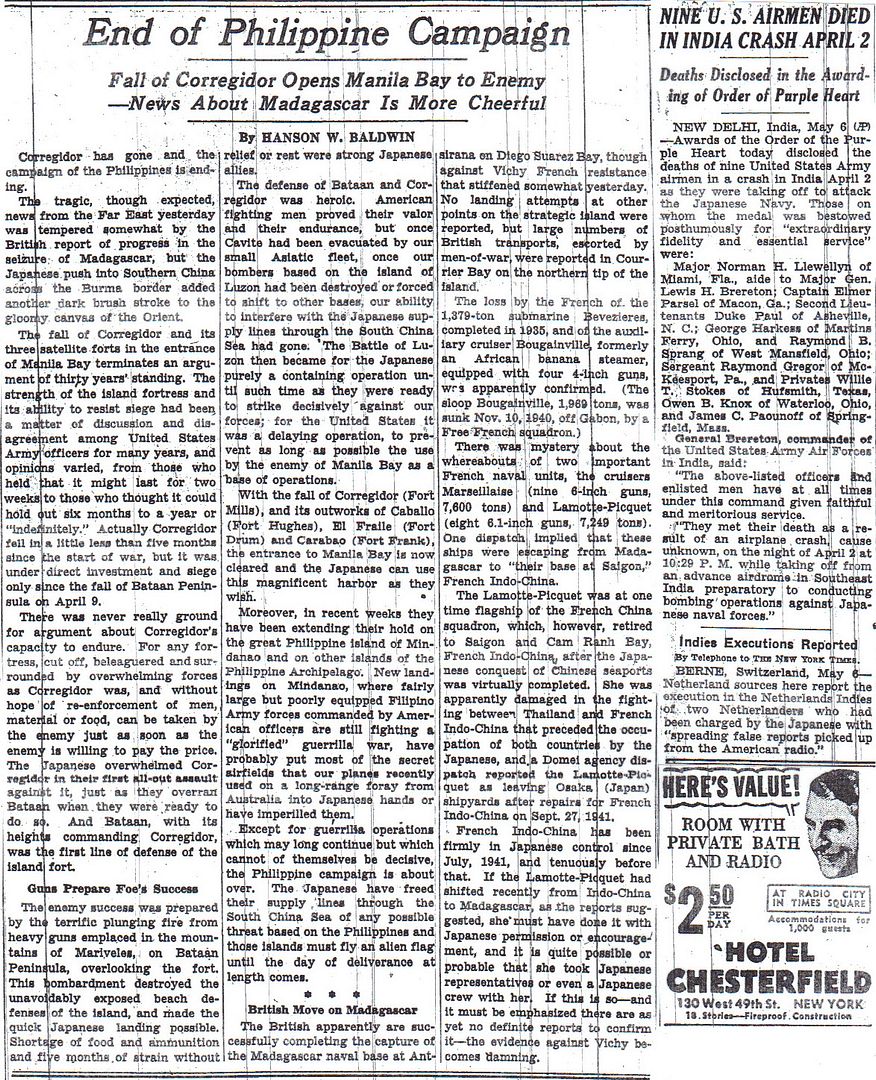
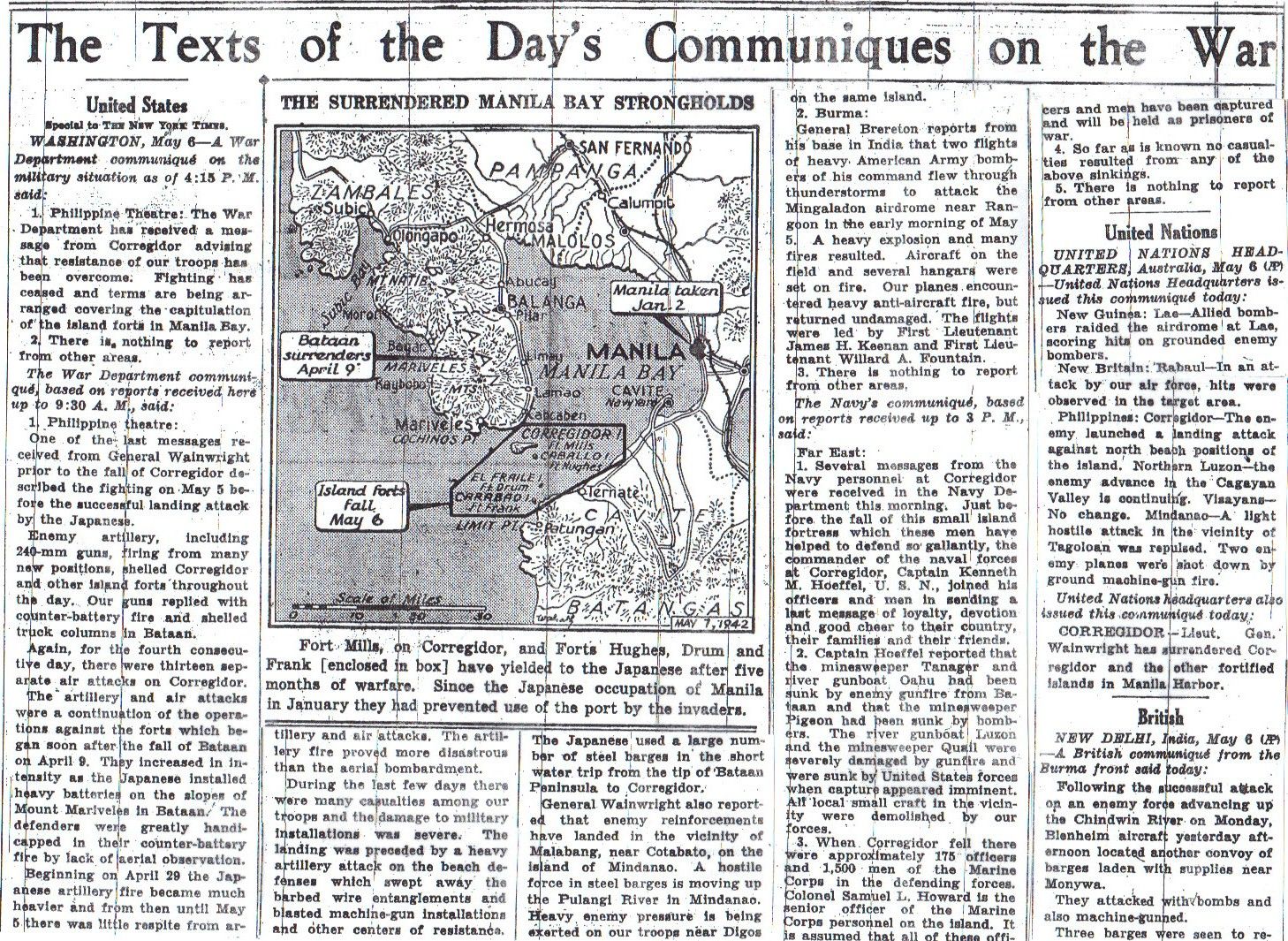
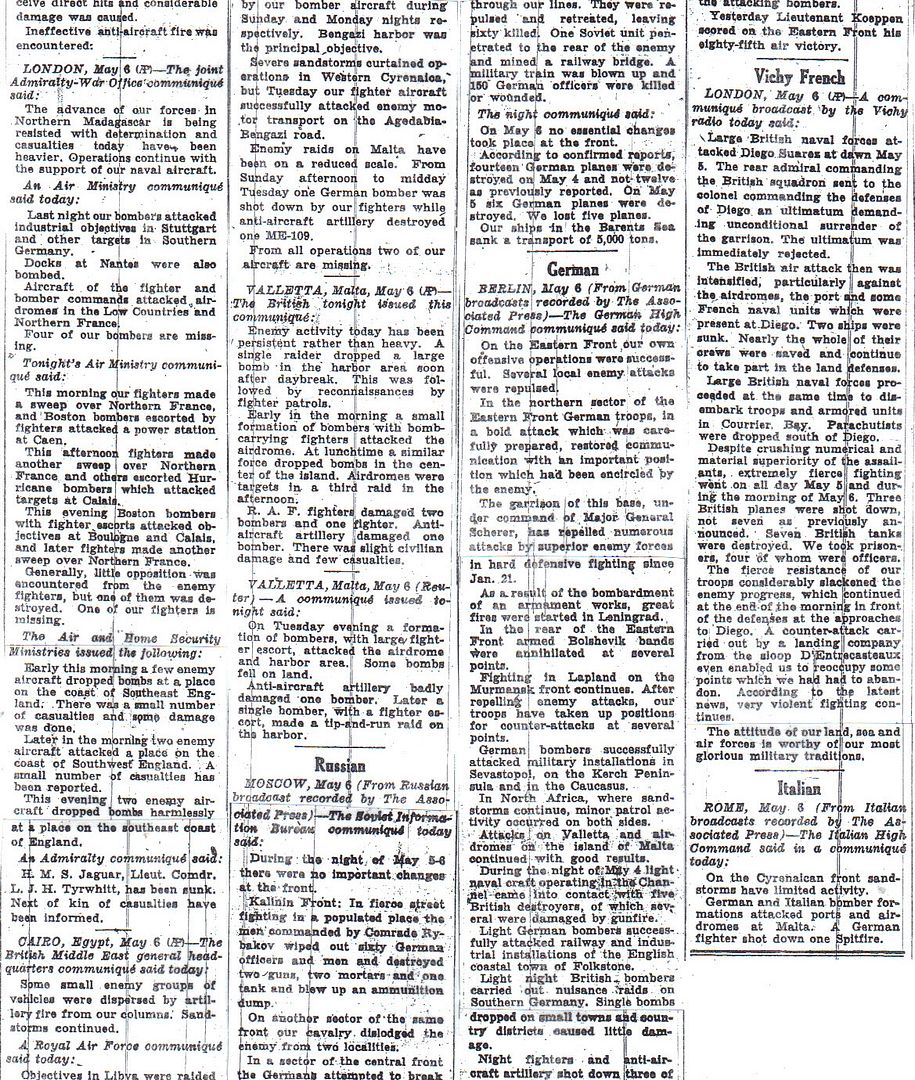
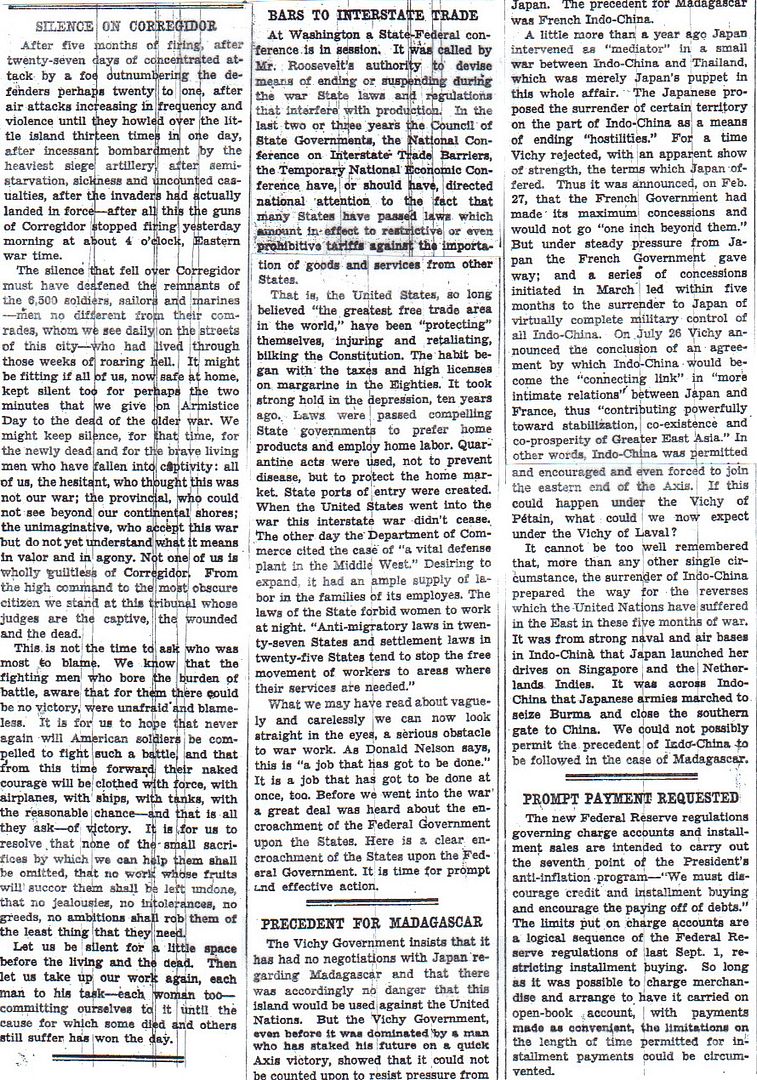
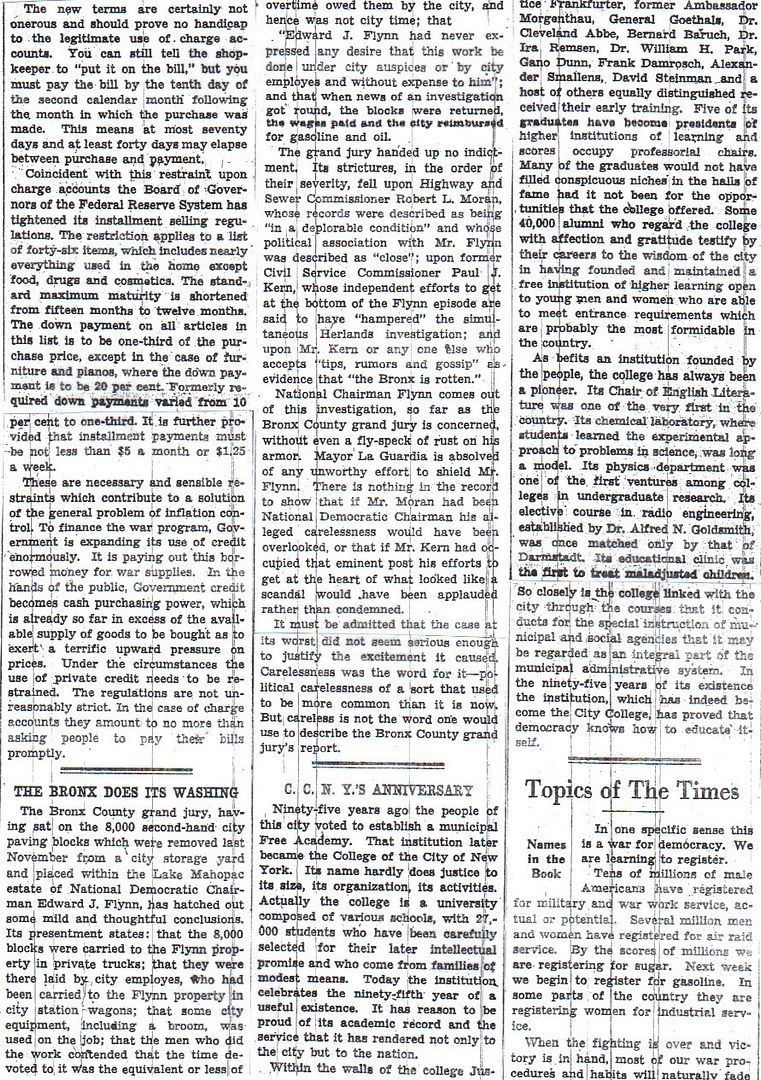

Philippines Lost (Hurd) – 2
Wainwright Stays to End by Choice (Schedler) – 3
Last News Items from Corregidor – 3
Invaders Gaining on Burma Highway – 5
Cruiser Bombed in Indies Home with Many Wounds – 6-7
War News Summarized – 6
End of Philippine Campaign (Baldwin) – 8
Texts of the Day’s Communiques on the War – 9-10
Editorials – 11-13
Silence on Corregidor
Bars to Interstate Trade
Precedent for Madagascar
Prompt Payment Requested
The Bronx Does Its Washing
C.C.N.Y.’s Anniversary
Topics of the Times
On Me Alone
http://www.onwar.com/chrono/1942/may42/f07may42.htm
General asks holdouts to surrender
Thursday, May 7, 1942 www.onwar.com
General Wainwright broadcasting after his surrender [photo at link]
In the Philippines... General Wainwright broadcasts the news of the American surrender at Corregidor from Japanese custody. He invites the remainder of the American forces in the Philippines to surrender. Despite the American surrender, the opposition faced by Japanese forces has been effective in disrupting their plans. General Homma was allocated 50 days to take the Philippines, the actual conquest took five months. The continuing resistance of the Filipino forces has prevented the release of his troops for other campaigns.
In the Coral Sea... American Admiral Fletcher sends Task Force 44 to attack Japanese troop transports bound for Port Moresby. The Japanese retaliate with attacks from land based aircraft. The Japanese also sight the American tanker Neosho and the Sims, they send aircraft after the ships and the Neosho is sunk. The Americans find Japanese Admiral Goto’s close support force and they proceed to sink the carrier Shoho. Meanwhile, Japanese Admiral Takagi sends planes out in an attempt to find the American fleet. Twenty-one of the Japanese planes are lost without engaging the enemy, including a small group which attempt to land on the American aircraft carrier Yorktown. The Japanese troop transports return to Rabaul to await the outcome of the battle.
In Madagascar... The Vichy commanders at Diego Suarez surrender to the British Admiral Syfret and General Sturges.
http://homepage.ntlworld.com/andrew.etherington/frame.htm
May 7th, 1942
UNITED KINGDOM: Escort carrier HMS Striker launched.
Destroyer HMS Tickham commissioned. (Dave Shirlaw)
GERMANY:
U-224 launched.
U-281, U-344 laid down.
U-519, U-621 commissioned. (Dave Shirlaw)
MADAGASCAR: Diego Suarez: The destroyer HMS ANTHONY ran through the Vichy-French batteries at full speed and came to a halt at the quay. 50 Marines leapt ashore. Behind the port were flashes from guns supporting the Royal Welch Fusiliers, Royal Scots Fusiliers and East Lancashire Fusiliers. The Marines pushed through the European town, where they met up with the Royal Welch. Diego Suarez surrendered today. The Allies believed that if Japan had taken the port first, it could control the Indian Ocean. In fact, Japan seems surprised by the invasion which is still being resisted by Vichy Forces elsewhere on the island.
INDIAN OCEAN: Submarine FS Le Heros sunk off Diego Suarez, Madagascar by aircraft from aircraft carrier HMS Illustrious. (Dave Shirlaw)
PACIFIC OCEAN: The Battle of Coral Sea begins. USS Sims, a destroyer is escorting the oiler USS Neosho. Both ships are sunk by Japanese aircraft. The US carrier planes find and sink the Shoho a smaller Japanese carrier.
While searching for the American task forces, an IJN search plane sights the oiler USS Neosho (AO-23) and its escort, the destroyer USS Sims (DD-409) at 0736 hours local. The USS Neosho had refuelled the American task forces on 5 and 6 May and were detached to continue to the next fuelling point. The Japanese search plane crew reports sighting a carrier and a cruiser and an all-out attack is launched from the Japanese carriers. At 0930 hours local, fifteen high level bombers attacked the two ships but did no damage; at 1038 hours, ten attacked the USS Sims, but skilful manouvering evaded the nine bombs that were dropped. A third attack against the two ships by 36 dive bombers was devastating. USS Neosho was soon a blazing wreck as the result of seven direct hits and one plane that dived into her. USS Sims was attacked from all directions. The destroyer was hit by three 500-pound (227 kg) bombs; two exploded in the engine room and, within minutes, the ship buckled amidships and began to sink, stern first.
As Sims slid beneath the waves, there was a tremendous explosion that raised what was left of the ship almost 15 feet (4.6 m) out of the water; there were only 16 survivors. The Neosho remains afloat for four days until the crew is rescued by aUSNdestroyer which then sinks the hulk with gunfire.
An American aircraft spots the small aircraft carrier HIJMS Shoho off Misima Island in the Louisiade Archipelago and 93 Douglas SBD Dauntlesses and TBD Devastators and Grumman F4F Wildcats are launched by the aircraft carriers USS Lexington (CV-2) and USS Yorktown (CV-5). The Japanese carrier is sunk and one of Lexington’s pilots reported this victory with the radio message, “Scratch one flattop.” That afternoon, the two IJN fleet carriers supporting the Japanese Port Moresby Invasion Force, HIJMS Shokaku and HIJMS Zuikaku, still unlocated by the Americans, launched 27 bombers and torpedo planes to search for the U.S. ships. Their flight proved uneventful until they ran into fighters from Yorktown and Lexington, who proceeded to down nine enemy planes in the ensuing dogfight. Near twilight, three Japanese planes incredibly mistook Yorktown for their own carrier and attempted to land. The ship’s gunfire, though, drove them off; and the enemy planes crossed Yorktown’s bow and turned away out of range. Twenty minutes later, when three more enemy pilots made the mistake of trying to get into Yorktown’s landing circle, the carrier’s gunners splashed one of the trio.
After receiving the news of the sinking of HIJMS Shoho, the Japanese Port Moresby Invasion Force reverses course and sails back to Rabaul on New Britain Island in the Bismarck Archipelago. (Jack McKillop)
NEW GUINEA: The Japanese occupy Hollandia.
COMMONWEALTH OF THE PHILIPPINES: General Wainright in Japanese custody announces the surrender of Corrigedor Island. The planned 50 day campaign by General Homma has taken over 150 days. The Filipino loyalty to the US has been a surprising development to the Japanese.
CANADA: AMC HMCS Prince Henry arrived Esquimalt, British Columbia.
Canadian fishing vessel Mildred Pauline (300 GRT) sunk south of St John’s by gunfire from U-136. There were no survivors. (Dave Shirlaw)
U.S.A.:
Destroyer USS Sims sunk by Japanese aircraft during the Battle of the Coral Sea, there were only 14 survivors
Destroyers USS Maddox, Nelson, Philip, Renshaw, William D Porter and Young laid down.
Minesweeper USS Oracle laid down.
Destroyer USS John Rodgers launched.
Destroyer USS Beatty commissioned. (Dave Shirlaw)
ATLANTIC OCEAN: Between 0227 and 0335, the unescorted and unarmed Ontario was shelled by U-507, while steaming a zigzag course at 12 knots. The day earlier, the ship was ordered to proceed to the nearest port after receiving a distress signal from the Alcoa Puritan, which was attacked and sunk by the same U-boat. The U-boat attacked from the port quarter and destroyed the bridge, wheelhouse and the mainmast, after a distress signal was sent and soon left the burning and sinking vessel. All 32 Americans, 11 Hondurians, one Dane and one British of the crew abandoned ship in three lifeboats and were picked up after six hours by patrol yacht USS Onyx and landed at Burwood, Louisiana. The burning ship was last seen at 0440 and a salvage crew returned later, but apparently she was gone down. The master Anders Weesgaard survived this sinking, but died when his next ship the San Blas was sunk by U-158 on 17 Jun 1942.
At 0800, the unescorted Frank Seamans was struck by one torpedo from U-162. After all crewmembers had abandoned ship in lifeboats, a second torpedo was fired which sank the ship. All hands were picked up by a Dutch ship the next day and taken to Paramaribo.
U-157 was attacked in the North Atlantic by the British submarine HMS P 44 with two torpedoes, but both missed.
U-371 was depth charged by two sub chasers. The boat was heavily damaged and had to return to base.
(Dave Shirlaw)
What’s amazing about this is I can find no article where the NY Times has printed seceret US plans or strategy or even bash the US and praise the Japs. Are you sure this is the NY Times?
http://www.history.navy.mil/photos/events/wwii-pac/coralsea/cs-3.htm
Battle of the Coral Sea, 7-8 May 1942
The Events of 7 May 1942
The first day of the carrier battle of Coral Sea, 7 May 1942, saw the Americans searching for carriers they knew were present and the Japanese looking for ones they feared might be in the area. The opposing commanders, U.S. Rear Admiral Frank Jack Fletcher and Japanese Vice Admiral Takeo Takagi and Rear Admiral Tadaichi Hara, endeavored to “get in the first blow”, a presumed prerequisite to victory (and to survival) in a battle between heavily-armed and lightly-protected aircraft carriers. However, both sides suffered from inadequate work by their scouts and launched massive air strikes against greatly inferior secondary targets, which were duly sunk, leaving the most important enemy forces unhit.
Japanese scouting planes spotted the U.S. oiler Neosho (AO-23) and her escort, the destroyer USS Sims (DD-409), before 8AM, in a southerly position well away from Admiral Fletcher’s carriers. Reported as a “carrier and a cruiser”, these two ships received two high-level bombing attacks during the morning that, as would become typical of such tactics, missed. However, about noon a large force of dive bombers appeared. As was normal for that type of attack, these did not miss. Sims sank with very heavy casualties and Neosho was reduced to a drifting wreck whose survivors were not rescued for days.
Meanwhile, a scout plane from USS Yorktown (CV-5) found the Japanese Covering Group, the light carrier Shoho and four heavy cruisers, which faulty message coding transformed into “two carriers and four heavy cruisers”. Yorktown and USS Lexington (CV-2) sent out a huge strike: fifty-three scout-bombers, twenty-two torpedo planes and eighteen fighters. In well-delivered attacks before noon, these simply overwhelmed the Shoho, which received so many bomb and torpedo hits that she sank in minutes. Her passing was marked by some of the War’s most dramatic photography.
Adding to the confusion, if not to the score, Japanese land-based torpedo planes and bombers struck an advanced force of Australian and U.S. Navy cruisers, far to the west of Admiral Fletcher’s carriers. Skillful ship-handling prevented any damage. Australia-based U.S. Army B-17s also arrived and dropped their bombs, fortunately without hitting anything.
All this had one beneficial effect: the Japanese ordered their Port Moresby invasion force to turn back to await developments. Late in the day, they also sent out nearly thirty carrier planes to search for Fletcher’s ships. Most of these were shot down or lost in night landing attempts, significantly reducing Japanese striking power. The opposing carrier forces, quite close together by the standards of air warfare, prepared to resume battle in the morning.
This page features views of the Japanese aircraft carrier Shoho under attack on 7 May 1942. They are presented in approximately the order in which they were taken.
Some things are still the same, 70 years later.
http://www.gwu.edu/~erpapers/myday/displaydoc.cfm?_y=1942&_f=md056179
My Day by Eleanor Roosevelt
MAY 7, 1942
No aid is being given to young people going to college or to high school. The high school aid is less necessary at this time, since more and more people are now employed and can give their children the little that is needed to make a high school education possible. To have college aid given up, however, seems to me rather tragic.
I had hoped that this part of NYA was just the beginning of a real democratization of education in this country. There is no reason why good students who should become professional people should be denied the opportunity to enter these fields simply because they can not afford to go to college. They will amply repay the country for their education.
Young people who have received NYA assistance in college have nearly always stood among the first ten of their class. All over the country the vast majority of college presidents are distressed at having this opportunity for education and usefulness taken away from young people just because they cannot pay for it. It is a short-sighted move and a present economy which will cost us dear in the future.
Eleanor’s journal is ongoing evidence that college is not for everyone. It reads like it was written by a slightly above-average high school student. Kind of like the writing of a certain contemporary POTUS.
Yes. Collectivism is the same, no matter the time frame.
With some of the students I’ve run across working in the help center I do have to say that, for some, there is no shame in trade school.
We did have the Chicago Tribune print details on the RAINBOW 5 plan just days before the attack on Pearl Harbor.
Disclaimer: Opinions posted on Free Republic are those of the individual posters and do not necessarily represent the opinion of Free Republic or its management. All materials posted herein are protected by copyright law and the exemption for fair use of copyrighted works.